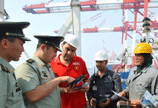China’s top soldier visits US
Updated: 2014-05-12 09:08
By CHEN WEIHUA in Washington(China Daily USA)
|
||||||||
General Fang Fenghui, the chief of general staff of China’s People’s Liberation Army, will visit the United States this week to meet his American counterpart and tour defense facilities, according to the Pentagon.
It will be one of a growing number of high-level exchanges between the two militaries amid an increasingly complex security situation in the Asia-Pacific region.
Pentagon Press Secretary John Kirby said on Friday that Fang will arrive in San Diego on Tuesday, where he will be hosted by the US 3rd Fleet, and tour aircraft carrier USS Ronald Reagan and littoral combat ship USS Coronado. Fang will also visit the US Marine Corps recruit depot there.
Fang’s visit is at the invitation of General Martin Dempsey, chairman of the Joint Chiefs of Staff, who went to China in April of last year at the invitation of Fang. The two will meet on Thursday at the Pentagon, where the Chinese general will receive a full military honors arrival ceremony, according to Kirby.
"General Dempsey looks forward to the opportunity to meet again with General Fang and to continue their conversation on improving our mil-to-mil relationship with China,"Kirby said.
Bonnie Glaser, a senior advisor for Asia at the Center for Strategic and International Studies, said signing agreements on notification of major military activities at sea and operational safety at sea is the highest priorities for the two militaries.
"The two militaries have been in negotiations since last year and hope to complete the agreements for signing during General Fang’s visit,"she said.
High-level military exchanges have been on the rise in the last two years. Chinese President Xi Jinping and US President Barack Obama agreed to increase high-level military exchanges when they met at the Sunnylands estate in California last June for an informal summit aimed at building a new type of major country relationship.
Just a month ago, US Secretary of Defense Chuck Hagel paid his first visit to China since taking office in February 2013. He met Chinese leaders and visited the PLA troops and academy.
US Army Chief of Staff General Raymond Odierno went to China in February, following trips there last September by US Air Force Chief of Staff General Mark Welsh III.
On the Chinese side, Defense Minister Chang Wanquan visited the US in August, followed by a trip in September by PLA Navy Commander-in-Chief Wu Shengli.
Fang’s visit will also come just less than two weeks before the start of the 2014 Rim of the Pacific (RIMPAC) naval exercise, set for June 26 and August 1. China and Brunei will be participating in the exercise for the first time since it was launched in 1971.
The PLA Navy will send four ships — a destroyer, a frigate, an oiler and a hospital ship — to the largest naval war game, which will involve 23 nations and 47 surface ships, six submarines, more than 200 aircraft and 25,000 troops. Former US Defense Secretary Leon Panetta extended the invitation during his visit to China in September 2012.
In February of this year, PLA soldiers also for the first time joined the annual multilateral Cobra Gold drills held in Thailand, led by the US and Thailand.
In the past, US and Chinese militaries had only engaged in bilateral and multilateral humanitarian assistance, disaster relief and anti-piracy drills in Hawaii, Southeast Asia and off Somalia.
However, Fang’s visit will also come at a time when tensions in both the South and East China Seas have intensified, especially between China and two US allies, Japan and the Philippines, over maritime territorial disputes.
While the US is eager to reassure its allies of the security alliance, many in China believe the US messages have emboldened its allies in the region to take a more confrontational attitude in the territorial disputes.
China has long regarded the US as biased toward its allies on issues in the South and East China Seas. It also expressed strong opposition at US arms sales to Taiwan, its military surveillance off China’s coast and certain US laws that restrict US-China military exchanges.
The two militaries have been aiming at each other strategically with the US launching an Air Sea Battle concept to thwart China’s Anti-Access/Area Denial strategy, the two strategies many worry will lead to a Cold War type of rivalry.
In a talk last week, James Steinberg, former deputy secretary of state and now a professor at Syracuse University, and Michael O’Hanlon, a senior fellow at the Brookings Institution, said both sides should exercise restraint in defensive actions that might appear threatening.
"This might mean Chinese willingness to slow the rate of its military buildup rather than race for parity. And for the United States, it might mean modifying its Air-Sea Battle concept, beginning with a more benign name such as Air-Sea Operations and a more inclusive approach toward implementation, to emphasize defensive objectives instead of offensive operations, which some Chinese view as seeking the ability to deliver a pre-emptive, knockout blow,"said the two, co-authors of the new book Strategic Reassurance and Resolve: US-China Relations in the Twenty-First Century.
- Xinjiang publishes anti-terror brochures
- Security pact sealed with Afghanistan
- President Xi encourages international cultural exchanges
- Premier Li: China willing to help Afghan infrastructure
- Chinese FM: China, Asia-Pacific become community of shared destiny
- Foreign minister remarks on possibility of China-Japan summit
Most Viewed
Editor's Picks

|

|

|

|

|

|
Today's Top News
VW defends safety of recalled New Sagitar
Former premier makes Hurun philanthropists list
Xinjiang publishes anti-terror brochures
SOHO endows $10m to Yale
Cook and Ma talk about partnership
Language a barrier to healthcare for Asian Americans
China businesses need innovation: VC
Security pact sealed with Afghanistan
US Weekly

|

|
















